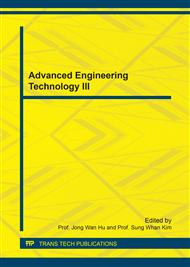p.239
p.247
p.253
p.259
p.263
p.270
p.275
p.282
p.289
Characteristics of Pervious Concrete with Environmental Friendly Based Binder
Abstract:
In general, the use of massive flexible and rigid pavement for road construction causing green land reduction that have an impact on the reduction of the catchment area. Therefore, the use of porous concrete is an environmentally friendly alternative. Its usage is expected to absorb water into the ground. Permeable pavements have different design goals if compared to the conventional pavement, due to the ability to infiltrate the storm water through the pavement surface. The purpose of this research is to get the optimum proportion of porous concrete mixture using a friendly environment binder material. Fly ash (FA) and silica fume (SF) were used to replace a certain part of the Portland Cement Composite (PCC). The maximum FA replacement referred to the proportions of the FA percentage in the massive paving industry (25%) and the maximum SF replacement (6%) as recommended by ACI 225R-10. The highest 90-day compressive strength gained by specimens of 12% PCC replacement by FA (5.87 MPa), which is 10.2% higher compared to the porous concrete compressive strength which binder composed of 12% FA and 6% SF replacement. The permeability varies at 28 days, but at the age of 90 days, the porous concrete permeability almost evenly, so that the influence of the 6% silica fume in the mixture is not indicated. The ratio of 6% replacement of cement by silica fume with no fly ash gave the highest permeability of 1.4 cm/s, approaching the previous research conducted by Schaefer, et al (2006), while at the age of 90 days the permeability of porous concrete (1.11 cm/s) closed with the results done by Montes (2006).
Info:
Periodical:
Pages:
263-269
Citation:
Online since:
June 2017
Authors:
Keywords:
Price:
Сopyright:
© 2017 Trans Tech Publications Ltd. All Rights Reserved
Share:
Citation:


